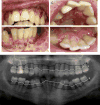A 17-year old patient with DOCK8 deficiency, severe oral HSV-1 and aggressive periodontitis - a case of virally induced periodontitis?
- PMID: 25600604
- PMCID: PMC4327766
- DOI: 10.1016/j.jcv.2014.12.003
A 17-year old patient with DOCK8 deficiency, severe oral HSV-1 and aggressive periodontitis - a case of virally induced periodontitis?
Abstract
We present a 17-year old girl with DOCK-8 deficiency, severe untreated oral HSV-1 infection and associated aggressive periodontitis. DOCK-8 deficiency is a primary immunodeficiency, caused by biallelicloss-of-function mutations in the DOCK8 gene, often leading to severe viral and fungal mucocutaneous infections. Nevertheless, to date DOCK8 has not been associated with severe periodontitis and inflammatory bone loss around teeth. Understanding whether DOCK8 deficiency or severe HSV-1 infection underlies susceptibility to periodontitis is central to this case and may provide insights into susceptibility factors for periodontitis in the general population. Our clinical and microbiological data suggest that severe HSV-1 infection is the driver of periodontal inflammation in this case.
Keywords: Aggressive periodontitis; DOCK8 deficiency; Oral HSV-1.
Published by Elsevier B.V.
Conflict of interest statement
The authors declare no competing interests
Figures




References
Publication types
MeSH terms
Substances
Grants and funding
LinkOut - more resources
Full Text Sources
Other Literature Sources
Medical

